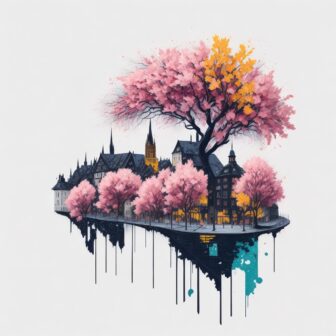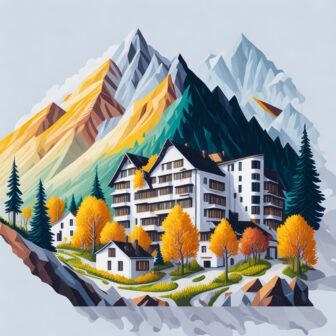16 Breathtaking Landscapes and Natural Wonders in Germany
Germany is home to some of the most stunning landscapes and natural wonders that look like they belong to another planet.
I’ve compiled a list of remarkable natural wonders that you may not have known existed in Germany.
From deep gorges and underground caves to picturesque mountain lakes and waterfalls, these destinations are perfect for your next weekend getaway in Germany.
Königssee, Bavaria
A Natural Wonder That Resembles a Norwegian Fjord The Königssee in Berchtesgaden is a serene emerald-green lake that stretches for eight kilometers, nestled between steep mountain slopes that look like a Norwegian fjord.
The lake remains relatively cool even in the summer months and is suitable for short dips. Take a quiet electric boat to cross the lake and visit the pilgrimage church of St. Bartholomew, which is one of the most beautiful churches in Germany.
You can also explore the Röthbach waterfall and the Landtalgraben waterfall at the Obersee.
Lüneburg Heath, Lower Saxony
The Largest Continuous Heathland in Europe South of Hamburg lies the Lüneburg Heath, which is the largest continuous heathland in Europe.
It attracts numerous visitors every year who come to explore its unique natural beauty. The knotty juniper bushes rising in bizarre shapes above the heath landscape create a stunning view, especially in the early hours of the day when the fog still lingers.
During your tour, you may also spot a flock of Heidschnucken sheep, which are mainly found in the Lüneburg Heath but can now be seen throughout the rest of Europe.
RELATED
Felsenmeer, Hesse
A Giant Stream of Stones That Looks Like a Sea of Rocks The Felsenmeer in Lautertal, Hesse, looks like a giant stream of stones that flowed down from the Felsenberg into the valley.
Legend has it that two giants who once lived there threw boulders at each other, burying one of them under the stones of the other. You can still hear him roar under the stones today, or so the legend says.
The Romans used to mine stones at the Felsenmeer, and you can still find 300 unfinished pieces distributed over 15 workshops that the Romans left behind.
Today, the Felsenmeer is a popular tourist attraction and a destination for hikers. After climbing, relax in one of the many spas in Hesse and take a break.
Kreidefelsen auf Rügen
The chalk cliffs of Rügen are not only the island’s landmark but also one of the most romantic destinations in Germany, attracting both active holidaymakers and nature lovers.
Their unique coloration, mixing the white of the cliffs with the green of the trees and the turquoise-blue of the water, make them a natural wonder and a must-visit attraction in Germany.
The most famous and highest viewpoint of the cliffs is the Königsstuhl, which offers a breathtaking panoramic view of the natural landscape of Germany and the Baltic Sea.
The Rügen chalk cliffs are located in the smallest of Germany’s 16 national parks, the Jasmund National Park.
Blautopf, Baden-Württemberg
The Blautopf is a stunningly blue lake located on the outskirts of the Swabian Alps in Baden-Württemberg. Its intense blue color shines beautifully when the sun is out.
It is the second most water-rich karst spring in Germany, with a depth of approximately 19 meters. Many legends and myths surround this lake, including the tale of a water nymph who thwarted attempts to reach the lake’s bottom with a plumb line and stole the weight.
Additionally, it is said that a banished water nymph from the Black Sea resides in the lake and cannot laugh. Experienced cave divers can explore the Blue Cave at the bottom of the lake.
Visitors can also explore the historic hammer mill and the stunning Blaubeuren Monastery, which is considered one of the most beautiful monasteries in Germany.
Wattenmeer, Niedersachsen und Schleswig-Holstein
The next natural wonder takes us to the far north of Germany, where the Wadden Sea of the North Sea is a 9000 square kilometer landscape shaped by the tides.
The Wadden Sea has been a UNESCO World Heritage site since 2009, and it is the largest tidal flats system in the world, making it a true natural wonder in Germany.
Twice a day, the sea recedes, offering visitors the chance to experience the Wadden Sea on foot, by horse-drawn carriage, or by guided tour. I
t is home to many different plant and animal species, and it is an important stopping point for many migratory birds. Visitors can even spot seals in the summer.
Spreewald, Brandenburg
In the southeast of the state of Brandenburg, you can find the beautiful landscape of Spreewald. This extensive lowland area is dominated by the natural branching of the Spree river.
Today, Spreewald is a popular recreational area and holiday destination in Germany.
You can take long hikes or explore the region on the many waterways. The culture of the Sorbs characterizes the Spreewald. It is known throughout the country mainly for the colorful Easter eggs.
If you want to relax for an additional day, you can do so wonderfully in the spas of Brandenburg. The Spreewald Therme, for example, is particularly popular.
Laacher See, Rhineland-Palatinate
In the Vulkaneifel in Rhineland-Palatinate, you can find the Laacher See. It is not only the largest lake in the state, but also almost circular.
Its shape is due to its volcanic origin, as it is actually a flooded volcanic crater. By the way, the volcano last erupted in 10930 BC. T
oday, it is a popular swimming lake in Germany and also offers other leisure activities. You can rent a boat, play mini golf or visit the nearby Benedictine abbey of Maria Laach.
Triberg Waterfalls, Baden-Württemberg
They are the highest waterfalls in all of Germany and plunge about 163 meters into the depths. The water finds its way down over a total of seven stages.
Especially when meltwater and heavy rainfall swell the water masses, the waterfalls show themselves in a special action.
A constructed walkway with a viewing platform allows you to get so close to the waterfalls that you can feel the spray on your skin.
The Triberg Waterfalls are only a few minutes’ walk from the city center and can be visited all year round. They are also atmospherically lit in the evenings from 10 pm.
However, they are not the only waterfalls in Germany. In total, there are around 500 waterfalls in Germany, most of them in Bavaria and Baden-Württemberg.
Kaltwassergeysir Andernach, Rhineland-Palatinate
In the Geopark Laacher See, there is another natural wonder that we do not want to withhold from you. On a peninsula in the Rhine river is the highest cold water geyser on earth.
The Andernach Geyser spits a water fountain into the air approximately every two hours for up to eight minutes. The jet reaches up to 60 meters high. In addition to the geyser, there is also the Geysir Andernach experience center, where you can learn everything about how a geyser works.
Usually, this can only be admired on a trip to Iceland. The geyser was already uncovered by drilling in 1903, and the water was able to reach the surface.
After a hiatus, the Andernach Geyser was redeveloped for tourism from 2005 and is now a popular attraction in the region. It is also one of the 15 masterpieces between the Rhine and Mosel rivers.
Saxon Switzerland, Saxony
Picturesque rock formations and a wonderful view of the Elbe River can be found in Saxon Switzerland, the German part of the Elbe Sandstone Mountains.
The Bastei with its Bastei Bridge is particularly well-known. For several centuries, Saxon Switzerland has been a popular hiking region and has served as inspiration for many artists’ paintings and poems.
Since 1990, the Saxon Switzerland National Park has existed and is the only rock national park. Numerous hiking trails run through the park, passing through rugged, chalk-era erosion landscapes.
Also nearby is Moritzburg Castle, which was not only a filming location for the Christmas classic “Three Hazelnuts for Cinderella,” but also one of the most beautiful castles in all of Germany.
Lange Anna in Helgoland, Schleswig-Holstein
She withstands wind and weather, although it has often been predicted that she will not hold up for much longer.
The Lange Anna is a roughly 47-meter-high surf column at the far northwest of Helgoland Island. Until 1860, the Lange Anna was part of a surf gate that was connected to the main island by a natural rock bridge.
Since 1976, the Lange Anna also has a little sister. During a rockfall, the Kurze Anna formed about 50 meters further east.
You can only admire the Lange Anna from the water or from the island. However, the Lange Anna, which is made of porous Heligoland sandstone, cannot be entered.
Feengrotte, Thuringia
Discover the mysterious world of the Feengrotte, a unique and young stalactite cave in Germany where the formations grow at an astonishing thousand times faster rate than in other rock formations.
This natural wonder was originally a mine for alum and vitriol until 1860, and was rediscovered in 1910. Its colorful stalactites have made it the “most colorful show cave in the world” listed in the Guinness Book of Records since 1993.
Visit the Feengrotte for a perfect family vacation and explore the adjacent Grottoneum and Feenwald.
Breitachklamm, Bavaria
Take a 2.5-kilometer hike through the Breitachklamm, the deepest gorge in the Bavarian Alps and the deepest rock canyon in Central Europe.
With a depth of up to 150 meters, the Breitachklamm is an exciting year-round destination. In summer and spring, enjoy the cool water and lush vegetation.
In autumn, experience the rising water levels and in winter, witness the mystical ice landscape. Don’t miss the chance to join the torchlight hike through the Breitachklamm, available every Tuesday to Friday during winter, with no prior registration required.
Tüchersfeld, Bavaria
Experience the beauty of Tüchersfeld, a charming village in Franconian Switzerland, belonging to the municipality of Pottenstein.
Admire the typical Franconian architecture of the houses, which appear to be taken out of a storybook. The village is also home to a unique rock formation that defies gravity and physics, making it a perfect postcard motif.
In fact, Tüchersfeld has even been featured on a stamp by the Deutsche Post.
Externsteine, North Rhine-Westphalia
The Externsteine, towering 40 meters high in the Teutoburg Forest, are a remarkable natural and cultural monument.
With their distinctive shape, they have been attracting visitors for centuries. You can climb the rock formations via staircases or explore some of the caves.
The Grottenfels has had a staircase since 1663, but it is still unknown who built it. The stones’ origins remain a mystery, with some theories suggesting their use in pre-Christian times and others proposing that monks from the surrounding monasteries carved the stones in the 11th and 12th centuries.
Visit the Externsteine and experience this unique natural wonder in Germany.
RELATED:
These are the most beautiful of the many landscapes and natural wonders in Germany that showcase the country’s stunning natural beauty. Whether you’re a local or a tourist, you’re sure to find something that will take your breath away.






